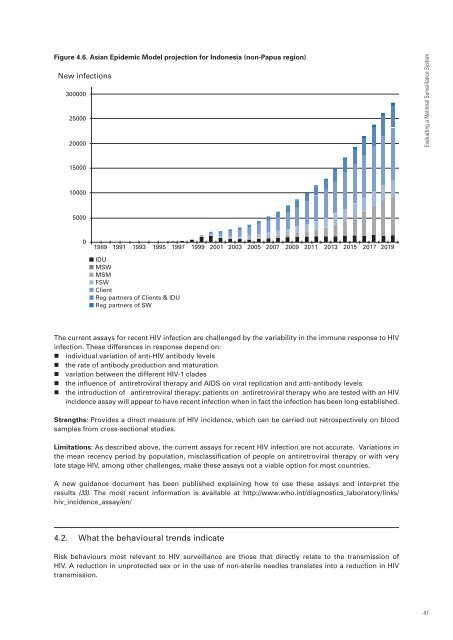Guidelines for second generation HIV surveillance - World Health ...
Guidelines for second generation HIV surveillance - World Health ...
Guidelines for second generation HIV surveillance - World Health ...
Create successful ePaper yourself
Turn your PDF publications into a flip-book with our unique Google optimized e-Paper software.
Figure 4.6. Asian Epidemic Model projection <strong>for</strong> Indonesia (non-Papua region)<br />
New infections<br />
300000<br />
25000<br />
20000<br />
Evaluating a National Surveillance System<br />
15000<br />
10000<br />
5000<br />
0<br />
1989 1991 1993 1995 1997 1999 2001 2003 2005 2007 2009 2011 2013 2015 2017 2019<br />
■ IDU<br />
■ MSW<br />
■ MSM<br />
■ FSW<br />
■ Client<br />
■ Reg partners of Clients & IDU<br />
■ Reg partners of SW<br />
The current assays <strong>for</strong> recent <strong>HIV</strong> infection are challenged by the variability in the immune response to <strong>HIV</strong><br />
infection. These differences in response depend on:<br />
• individual variation of anti-<strong>HIV</strong> antibody levels<br />
• the rate of antibody production and maturation<br />
• variation between the different <strong>HIV</strong>-1 clades<br />
• the influence of antiretroviral therapy and AIDS on viral replication and anti-antibody levels<br />
• the introduction of antiretroviral therapy: patients on antiretroviral therapy who are tested with an <strong>HIV</strong><br />
incidence assay will appear to have recent infection when in fact the infection has been long established.<br />
Strengths: Provides a direct measure of <strong>HIV</strong> incidence, which can be carried out retrospectively on blood<br />
samples from cross-sectional studies.<br />
Limitations: As described above, the current assays <strong>for</strong> recent <strong>HIV</strong> infection are not accurate. Variations in<br />
the mean recency period by population, misclassification of people on antiretroviral therapy or with very<br />
late stage <strong>HIV</strong>, among other challenges, make these assays not a viable option <strong>for</strong> most countries.<br />
A new guidance document has been published explaining how to use these assays and interpret the<br />
results (33). The most recent in<strong>for</strong>mation is available at http://www.who.int/diagnostics_laboratory/links/<br />
hiv_incidence_assay/en/<br />
4.2. What the behavioural trends indicate<br />
Risk behaviours most relevant to <strong>HIV</strong> <strong>surveillance</strong> are those that directly relate to the transmission of<br />
<strong>HIV</strong>. A reduction in unprotected sex or in the use of non-sterile needles translates into a reduction in <strong>HIV</strong><br />
transmission.<br />
47
















